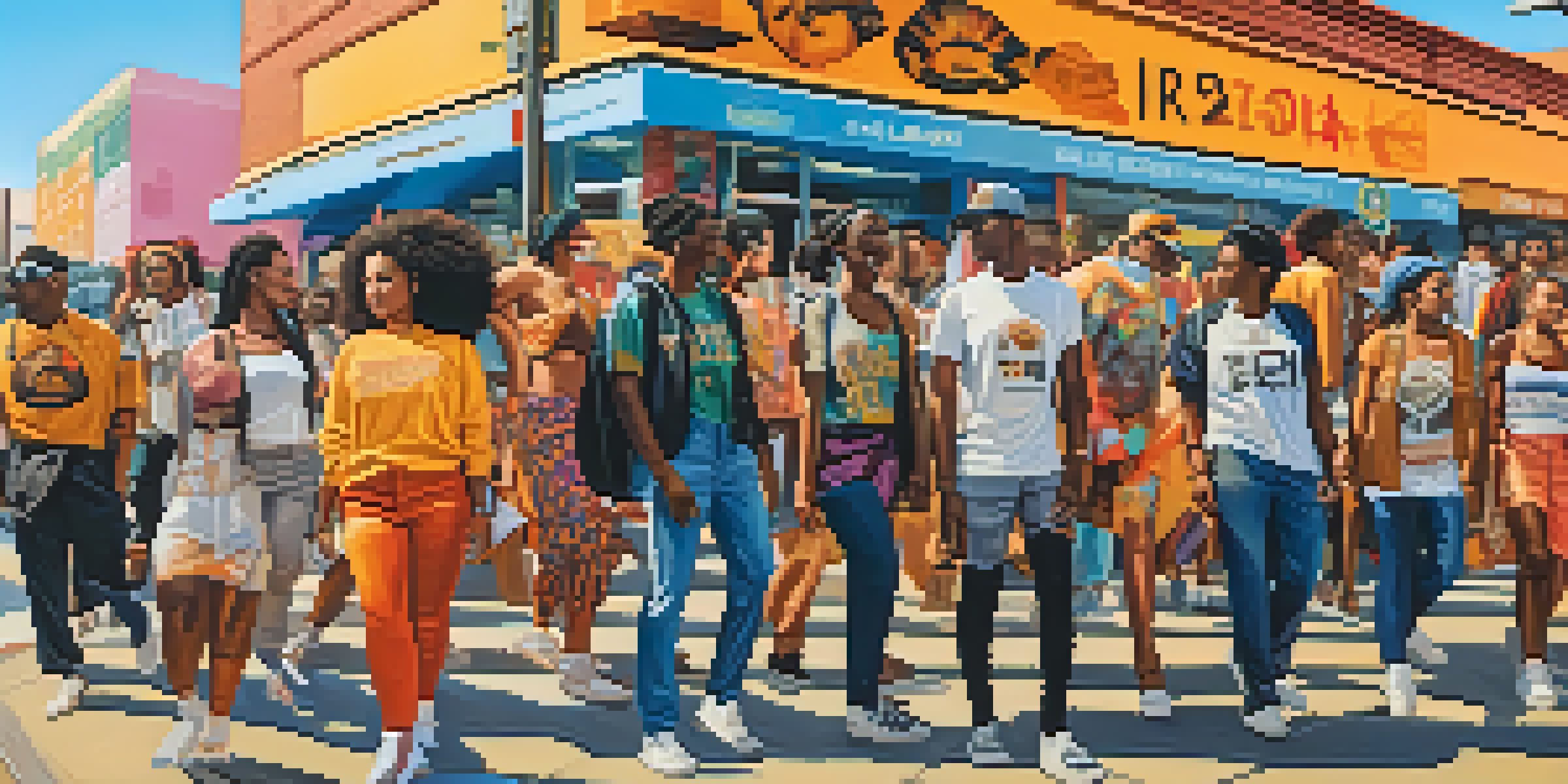Fashion Activism: Brands Championing Social Justice Movements

The Rise of Fashion Activism in Modern Culture
Fashion activism has emerged as a powerful force in recent years, blending style with social responsibility. This movement encourages brands and consumers alike to take a stand on pressing social issues, from racial equality to climate change. As awareness grows, more people are recognizing that fashion can be a platform for change, not just a means of self-expression.
Fashion is the armor to survive the reality of everyday life.
Brands are now leveraging their influence to raise awareness and push for social justice. For instance, many fashion houses have embraced campaigns that support marginalized communities, using their visibility to spark conversations about inequality. With consumers increasingly seeking purpose-driven brands, fashion activism is becoming a vital part of the industry landscape.
Additionally, this shift reflects a broader cultural transformation, where individuals are more aware of the impact their choices can have. Fashion is no longer just about looking good; it’s about feeling good about what you wear and the values you support. This newfound consciousness is driving brands to adopt more ethical practices and align themselves with social movements.
Notable Brands Making a Difference
Several prominent fashion brands have stepped up to champion social justice, setting a powerful example for others. Brands like Nike and Adidas have launched campaigns that not only promote their products but also highlight critical social issues, such as racial injustice and LGBTQ+ rights. Their efforts resonate with consumers who value authenticity and commitment to causes beyond profit.

Another example is Patagonia, which has long been at the forefront of environmental activism. By donating a percentage of their profits to environmental causes and encouraging customers to repair rather than replace their gear, they embody the principles of sustainability and social responsibility. Their approach shows that brands can prioritize the planet while still thriving economically.
Fashion as a Platform for Change
Fashion activism blends style with social responsibility, encouraging brands and consumers to advocate for social issues.
Similarly, Fenty Beauty, founded by Rihanna, has made waves with its inclusive approach to beauty. By offering a diverse range of shades and promoting representation, Fenty has sparked important conversations about inclusivity in the beauty industry. This commitment to social justice resonates with consumers who appreciate brands that reflect their values and experiences.
The Power of Collaborations and Partnerships
Collaborations between fashion brands and social justice organizations have proven to be incredibly impactful. These partnerships amplify messages and create greater awareness around important issues. For example, many brands have teamed up with non-profits to develop limited-edition collections, with proceeds going directly to support social movements.
The future belongs to those who believe in the beauty of their dreams.
These collaborations not only provide financial support but also bring visibility to the causes they represent. When a well-known brand aligns itself with a social justice initiative, it can significantly boost public awareness and engagement. This synergy between fashion and activism creates a ripple effect that can inspire others to get involved.
Moreover, these partnerships often resonate deeply with consumers, creating a sense of community and shared purpose. When shoppers support brands that give back, they feel they are part of something bigger than themselves. This connection not only enhances brand loyalty but also encourages more brands to embrace activism as part of their identity.
Consumer Expectations and Brand Responsibilities
Today’s consumers are more informed and socially conscious than ever, leading them to expect brands to take a stand on social issues. This shift in expectation challenges brands to align their values with those of their customers. Failing to do so can result in backlash, as consumers increasingly demand transparency and authenticity from the brands they support.
For instance, younger generations are particularly vocal about the need for brands to engage in social justice. They want to see brands actively participating in movements, not just paying lip service to them. This expectation has created a new norm where social responsibility is no longer optional but a fundamental aspect of a brand’s identity.
Brands Leading Social Justice
Prominent brands like Nike, Patagonia, and Fenty Beauty are setting examples by actively supporting social causes and promoting inclusivity.
As a result, many brands are reevaluating their practices and messaging to ensure they resonate with their audience. This evolution can lead to more ethical sourcing, fair labor practices, and community engagement initiatives. Ultimately, brands that embrace these responsibilities are more likely to cultivate lasting relationships with their customers.
The Impact of Social Media on Fashion Activism
Social media has revolutionized the way fashion activism is communicated and amplified. Platforms like Instagram and TikTok give brands and activists the ability to share their messages instantaneously, reaching a global audience. This immediacy allows for real-time engagement and mobilization around social issues, creating a sense of urgency and relevance.
Moreover, social media serves as a powerful tool for grassroots movements. Activists can harness these platforms to organize campaigns, share stories, and rally support. The viral nature of social media can catapult local initiatives into global movements, showcasing the potential of collective action in the digital age.
Additionally, consumers are now more equipped than ever to hold brands accountable through social media. If a brand makes a misstep or fails to uphold its promises, consumers can voice their dissatisfaction to a wide audience. This level of scrutiny encourages brands to remain vigilant and authentic in their advocacy efforts.
Challenges Faced by Fashion Activism
Despite the progress made, fashion activism is not without its challenges. One major issue is the risk of 'performative activism,' where brands promote social causes without genuine commitment. This can lead to skepticism among consumers who are quick to call out brands that appear to exploit social issues for marketing purposes.
Another challenge is the balancing act brands must perform between profitability and activism. While many consumers support purpose-driven brands, the pressure to maintain financial performance can lead to compromises in ethical practices. Brands must navigate these complexities carefully to ensure their activism is both impactful and sustainable.
Consumer Expectations Drive Activism
Today's consumers demand transparency and social responsibility from brands, pushing them to align their values with those of their audience.
Furthermore, the fast-paced nature of the fashion industry can conflict with the slow, deliberate work required for meaningful social change. Activism often takes time to cultivate and nurture, whereas fashion cycles demand quick turnarounds. This dissonance can hinder the effectiveness of activism efforts within the industry.
The Future of Fashion Activism
Looking ahead, the future of fashion activism appears promising, yet requires continuous commitment from brands. As consumers become increasingly aware of the impact of their purchasing decisions, brands that prioritize social justice will likely thrive. The challenge will be to maintain authenticity while scaling their efforts to drive real change.
Moreover, emerging technologies and innovations present new opportunities for brands to engage in activism. For example, virtual reality and augmented reality can create immersive experiences that educate consumers about social issues. By leveraging these technologies, brands can enhance their storytelling and foster deeper connections with their audience.

Ultimately, the continued evolution of fashion activism will rely on collaboration and collective action. As brands, activists, and consumers unite for common causes, they can create a more equitable and just industry. This shared vision for the future not only benefits society but also enriches the fashion landscape, making it a vibrant space for creativity and change.